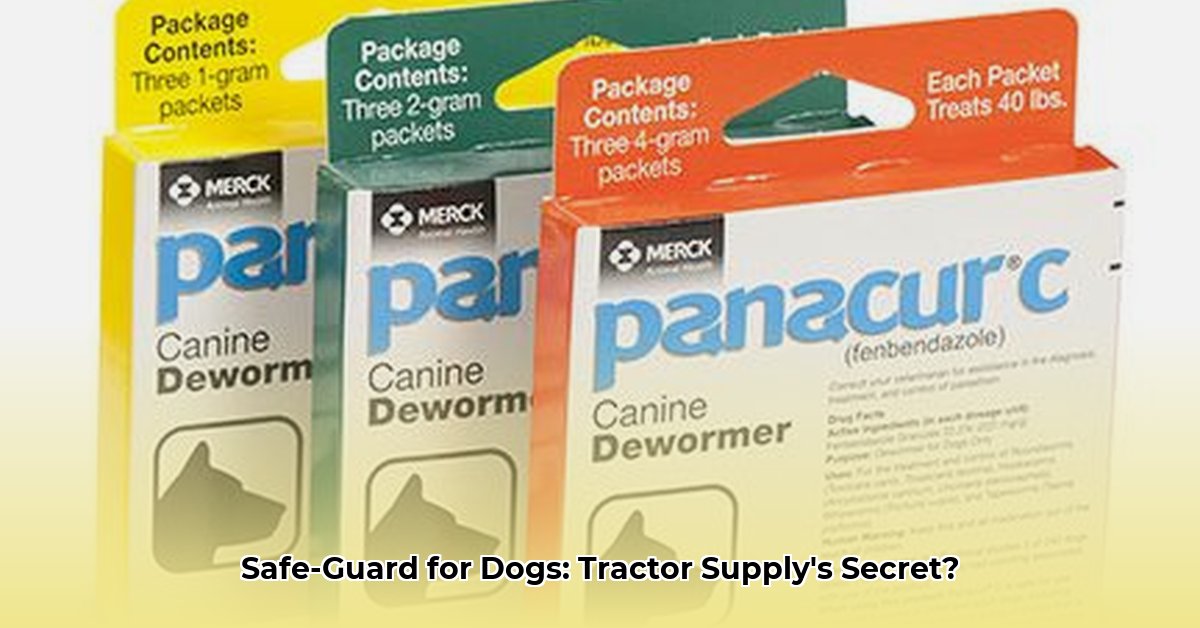
Finding the right dewormer for your dog can be challenging. This review examines Safe-Guard Canine Dewormer, a readily available option at Tractor Supply, focusing on its efficacy, application, potential risks, and overall suitability.
Safe-Guard: A Critical Analysis
Safe-Guard, manufactured by Merck Animal Health and containing fenbendazole, is marketed as a broad-spectrum dewormer (a medication targeting various worms). It claims effectiveness against roundworms, hookworms, whipworms, and tapeworms. However, it's crucial to understand that these are manufacturer claims, and the absence of extensive, independent scientific verification warrants caution. While Tractor Supply sells the product, they don't independently validate these claims. Further research is needed to completely confirm Safe-Guard's efficacy against all listed parasites in diverse real-world scenarios.
Dosage and Administration: A Practical Guide
The recommended dosage is generally one gram of Safe-Guard per ten pounds of body weight, administered daily for three consecutive days. This simple regimen is convenient for pet owners. However, the instructions lack guidance on adjusting dosage for dogs with severe infestations. This omission is a significant concern. Veterinary consultation is strongly recommended for such cases, as the veterinarian can advise on correct medication and dosage, and may use different treatment approaches. Incorrect dosage could prove ineffective or even harmful.
Potential Risks and Side Effects: A Risk Assessment Matrix
While the manufacturer reports minimal side effects, this is based on their observations and lacks comprehensive independent verification. We must also consider the lack of large-scale, long-term studies evaluating the potential for long-term effects, including the development of parasite resistance. The development of resistant parasite strains due to repeated fenbendazole exposure is a genuine concern in anthelmintic treatment. Parasites are highly adaptable organisms; the potential for unforeseen consequences exists.
| Risk Factor | Likelihood (Scale: Low, Medium, High) | Severity (Scale: Low, Medium, High) | Mitigation Strategy |
|---|---|---|---|
| Incorrect dosage | Medium | High | Accurate weight measurement, veterinary consultation for dosage adjustments |
| Allergic reaction | Low | High | Monitor for signs (vomiting, itching, swelling), seek immediate veterinary attention |
| Parasite resistance | Low | Medium | Alternate dewormers, prevent repeat infestations |
| Lack of efficacy against all parasites | Medium | Medium | Veterinary diagnosis to confirm parasite type and treatment efficacy |
| Unknown long-term effects | Low | Medium | Regular veterinary check-ups |
Safe-Guard: Advantages and Disadvantages
This table summarizes the key aspects of Safe-Guard to aid in your decision-making process:
| Advantages | Disadvantages |
|---|---|
| Readily available and relatively inexpensive | Limited independent scientific evidence to support all efficacy claims |
| Simple dosage instructions | No dosage adjustments given for heavy infestations; veterinary consultation necessary |
| Broad-spectrum coverage (manufacturer claim) | Potential for long-term side effects and parasite resistance remains largely unknown |
Making Informed Decisions: A Veterinary Perspective
The choice to use Safe-Guard, or any other dewormer, is a decision that should involve your veterinarian. They can accurately diagnose and treat any parasitic infection, prescribe the appropriate medication and dosage, and provide guidance on preventative measures. Regular fecal exams are crucial for early detection and effective parasite management. Preventative care, combined with veterinary consultation, is vital for your pet’s long-term health. Don't rely solely on over-the-counter solutions without professional oversight.
Step-by-Step Guide to Safe Safe-Guard Administration
- Weight Measurement: Accurately weigh your dog using a reliable scale.
- Dosage Calculation: Follow the Safe-Guard label instructions precisely, calculating the correct dosage based on your dog's weight.
- Medication Administration: Administer the medication as directed on the label. Most commonly, the medication is mixed in with food.
- Treatment Duration: Administer the medication daily for three consecutive days unless otherwise directed by your veterinarian.
- Post-Treatment Monitoring: Carefully monitor your dog for any adverse reactions (vomiting, diarrhea, loss of appetite).
- Follow-Up: Schedule a follow-up appointment with your veterinarian for a fecal examination to verify the effectiveness of the treatment.
Remember: This guide provides general information. Always consult your veterinarian before using Safe-Guard or any other dewormer. Individual needs vary greatly, and a tailored approach is crucial for optimal results and safety.